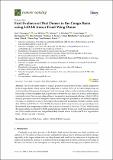Files in this item
First evidence of peat domes in the Congo Basin using LiDAR from a fixed-wing drone
Item metadata
| dc.contributor.author | Davenport, Ian J. | |
| dc.contributor.author | McNicol, Iain | |
| dc.contributor.author | Mitchard, Edward T. A. | |
| dc.contributor.author | Dargie, Greta | |
| dc.contributor.author | Suspense, Ifo | |
| dc.contributor.author | Milongo, Brice | |
| dc.contributor.author | Bocko, Yannick E. | |
| dc.contributor.author | Hawthorne, Donna | |
| dc.contributor.author | Lawson, Ian | |
| dc.contributor.author | Baird, Andy J. | |
| dc.contributor.author | Page, Susan | |
| dc.contributor.author | Lewis, Simon L. | |
| dc.date.accessioned | 2020-07-15T16:30:16Z | |
| dc.date.available | 2020-07-15T16:30:16Z | |
| dc.date.issued | 2020-07-09 | |
| dc.identifier | 269162258 | |
| dc.identifier | 674797c3-7bd2-42fb-bfe2-cd1e557d362a | |
| dc.identifier | 000558696400001 | |
| dc.identifier | 85088637504 | |
| dc.identifier.citation | Davenport , I J , McNicol , I , Mitchard , E T A , Dargie , G , Suspense , I , Milongo , B , Bocko , Y E , Hawthorne , D , Lawson , I , Baird , A J , Page , S & Lewis , S L 2020 , ' First evidence of peat domes in the Congo Basin using LiDAR from a fixed-wing drone ' , Remote Sensing , vol. 12 , no. 14 , 2196 . https://doi.org/10.3390/rs12142196 | en |
| dc.identifier.issn | 2072-4292 | |
| dc.identifier.other | Bibtex: rs12142196 | |
| dc.identifier.other | ORCID: /0000-0002-3547-2425/work/77524808 | |
| dc.identifier.uri | https://hdl.handle.net/10023/20260 | |
| dc.description | This work was funded by CongoPeat, a NERC Large Grant (NE/R016860/1) to S.L.L. and E.T.A.M. (UAV data collection, I.J.D. time), a NERC Open CASE Studentship to S.L.L., I.L. and G.D. and a Phillip Leverhulme Prize to S.L.L. (peat depths). | en |
| dc.description.abstract | The world’s most extensive tropical peatlands occur in the Cuvette Centrale depression in the Congo Basin, which stores 30.6 petagrams of carbon (95% CI, 6.3–46.8). Improving our understanding of the genesis, development and functioning of these under-studied peatlands requires knowledge of their topography and, in particular, whether the peat surface is domed, as this implies a rain-fed system. Here we use a laser altimeter mounted on an unmanned airborne vehicle (UAV) to measure peat surface elevation along two transects at the edges of a peatland, in the northern Republic of Congo, to centimetre accuracy and compare the results with an analysis of nearby satellite LiDAR data (ICESat and ICESat-2). The LiDAR elevations on both transects show an upward slope from the peatland edge, suggesting a surface elevation peak of around 1.8 m over ~20 km. While modest, this domed shape is consistent with the peatland being rainfed. In-situ peat depth measurements and our LiDAR results indicate that this peatland likely formed at least 10,000 years BP in a large shallow basin ~40 km wide and ~3 m deep. | |
| dc.format.extent | 4009766 | |
| dc.language.iso | eng | |
| dc.relation.ispartof | Remote Sensing | en |
| dc.subject | Peat | en |
| dc.subject | LiDAR | en |
| dc.subject | Dome | en |
| dc.subject | Carbon | en |
| dc.subject | ICE Sat | en |
| dc.subject | ICE | en |
| dc.subject | G Geography (General) | en |
| dc.subject | NDAS | en |
| dc.subject.lcc | G1 | en |
| dc.title | First evidence of peat domes in the Congo Basin using LiDAR from a fixed-wing drone | en |
| dc.type | Journal article | en |
| dc.contributor.sponsor | NERC | en |
| dc.contributor.institution | University of St Andrews. School of Geography & Sustainable Development | en |
| dc.contributor.institution | University of St Andrews. Environmental Change Research Group | en |
| dc.contributor.institution | University of St Andrews. Bell-Edwards Geographic Data Institute | en |
| dc.identifier.doi | https://doi.org/10.3390/rs12142196 | |
| dc.description.status | Peer reviewed | en |
| dc.identifier.grantnumber | NE/R016860/1 | en |
This item appears in the following Collection(s)
Items in the St Andrews Research Repository are protected by copyright, with all rights reserved, unless otherwise indicated.

